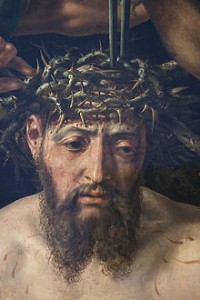 As we begin the most solemn time of year we call Holy Week, leading up to the great Triduum, Holy Thursday, Good Friday, and Holy Saturday, bringing us to the high point of the liturgical year at Easter, we should reflect more intensely on the humanity of Christ and His suffering, through which He gained our redemption.
As we begin the most solemn time of year we call Holy Week, leading up to the great Triduum, Holy Thursday, Good Friday, and Holy Saturday, bringing us to the high point of the liturgical year at Easter, we should reflect more intensely on the humanity of Christ and His suffering, through which He gained our redemption.
We have lived, at least vicariously, through a lot of suffering the past year. Wars and rumours of wars, ebola, legions of refugees, plane crashes and natural disasters. As many ask in the comments sections on news reports, where is God in all of this?
There is no easy answer to that question, but Pope John Paul II summarizes (beautifully, as usual) what the Catholic faith and reason offer to unraveling the mysterium iniquitatis in his 1984 Apostolic Letter Salvifici Doloris, on the purpose not only of human suffering, but of Christ’s, and how the two relate.
In His Incarnation, Christ took upon Himself not just all sin, but all of the suffering for sin, which means all human suffering in toto. Originally created impassible, every pain that Man now experiences, directly or indirectly, can be traced back to sin, the original of Adam, and each of our personal, which always have an effect upon the world, upon ourselves, and upon others. It is these deleterious effects of sin, what we experience as ‘punishment’, that have to be expiated and atoned for, in some way. We do this as a society in a limited way by meting out human justice in courtrooms, but as Pope Benedict made clear, such justice never suffices to atone for the full gravity of ‘sin’ (even for those who may not use the word, everyone believes in offense of some sort, and everyone has some idea, at least vague, of human guilt).
The Incarnation of Christ, and ultimately His Passion and Death, are the means by which God willed to atone for these effects of sin, to ‘make up’ the emptiness and darkness that sin causes, filling it with goodness and light.
There are two things I would like to offer in this brief reflection: The necessity of Christ’s sufferings, and their extent. Saint Thomas asks whether Christ had to suffer, or, as we may imply in our own idioms, was it an exercise in masochism, as much of the world now views voluntarily endured pain? Thomas rightly answers that God could have saved us in any number of ways, but taking on our human nature and suffering for us was the most fitting. As such, Christ suffered voluntarily, freely accepting His death, “even death on the Cross”. There are a number of reasons for this ‘fittingness’: To offer us an example of the inestimable salvific value of human suffering, to demonstrate the gravity of sin and separation from God, and, most of all, to leave us a vivid, unforgettable example of His love. For nothing so proves love than the demonstration that one is willing to endure pain, even to the point of death, for one’s beloved. Martyrdom, from the Greek for ‘witness’, is therefore the ultimate proof of one’s love, especially the love of Christ and His Truth.
A word also on the intensity and extent of Christ’s sufferings. We may think that many martyrs have suffered more than Christ appeared to; some of the Vietnamese and Japanese Christians put to death lingered for weeks or years in horrific cruelty. Of course, one must not downplay the brutal tortures of Roman scourging and crucifixion, by a culture that brought the infliction of pain to a high art. The French physician Pierre Barbet described this in great detail in his fascinating A Doctor at Calvary, and a visual witness is left for us by the Shroud of Turin.
Yet the physical suffering that Christ underwent, which we commemorate especially on Good Friday, is but a sacrament, a sign, into the far greater spiritual sufferings He endured. We must always remember that the One who suffered was not a human person, but a Divine One, who could, through His humanity, take on Himself all the punishment for sin, for all time, in its infinite extent, even the very pain of separation from the Father. As Pope Saint John Paul II put it, in a brief passage worth quoting in full:
“this Son who is consubstantial with the Father suffers as a man. His suffering has human dimensions; it also has, unique in the history of humanity, a depth and intensity which, while being human, can also be an incomparable depth and intensity of suffering, insofar as the man who suffers is in person the only-begotten Son himself: ” God from God”. Therefore, only he—the only-begotten Son—is capable of embracing the measure of evil contained in the sin of man: in every sin and in “total” sin, according to the dimensions of the historical existence of humanity on earth.”
It is what exists ‘behind’ the veil of Christ’s human sufferings that should be the ultimate point of our reflections during Holy Week, the primary nature of sin as a spiritual evil, an evil which prevents the true nature of Man being revealed, Man as a spiritual, eternal being, made in the very image of God, called beyond the passing goods of this world, to the joys of eternal life in the Resurrection. Only in this light does suffering, Christ’s and our own, even the very suffering of death, make sense, and only to this purpose is it salvific.
Monday of Holy Week, 2015
(A shorter version of this column will appear on Our Lady Seat of Wisdom’s webpage)
